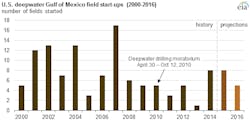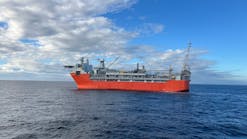EIA forecasts continued rise in US oil production from gulf
Crude oil production from the Gulf of Mexico will reach 1.52 million b/d in 2015 and 1.61 million b/d in 2016—or respectively 16% and 17% of total US crude production during each year—according to projections from the US Energy Information Administration.
The forecasted growth is driven both by new projects and the redevelopment and expansion of older producing fields.
During last year’s second half, production launched from five deepwater projects:
• Murphy Oil Corp.-operated Dalmatian.
• Royal Dutch Shell PLC-operated Cardamom Deep (OGJ Online, Sept. 8, 2014).
• Hess Corp.-operated Tubular Bells (OGJ Online, Nov. 17, 2014).
• Chevron Corp.-operated Jack-St. Malo (OGJ Online, Dec. 2, 2014).
• Stone Energy Corp.-operated Cardona (OGJ Online, Dec. 4, 2014).
The redevelopment of Shell’s Mars field and BP PLC’s Na Kika field—both mature—occurred at the beginning of the year (OGJ Online, Feb. 4, 2014; Feb. 24, 2014).
EIA says the increase in fields that came online in 2014 and are scheduled for production start-up in 2015 and 2016 reflect a revival of interest and activity in the gulf following the moratorium on deepwater drilling after the 2010 Deepwater Horizon incident.
The moratorium ended Oct. 12, 2010, after which relatively few field start-ups occurred through 2013.
Thirteen fields are expected to start up in the next 2 years, of which eight will come online this year and five next year. More than half the projects starting up during that time will utilize subsea tiebacks to existing production platforms.
New projects, combined with continuing production from the developments brought online in last year’s second-half, are forecast to add 265,000 b/d by yearend. Production estimates include adjustments to account for seasonal shut-ins from hurricanes.
EIA notes, however, that the current low oil price environment adds uncertainty to the timelines of deepwater gulf projects, with those in early development stages exposed to the greatest risk of delay.
To reduce risk, producers are collaborating to develop projects more cost-effectively, to shorten the time to final investment decision and production launch, and by sharing development costs.
Notably, Chevron, BP, and ConocoPhillips in January reported plans to together explore and appraise 24 jointly held offshore leases in the northwest portion of Keathley Canyon (OGJ Online, Jan. 28, 2015).



